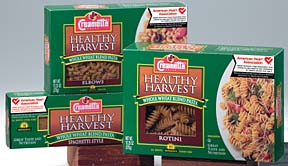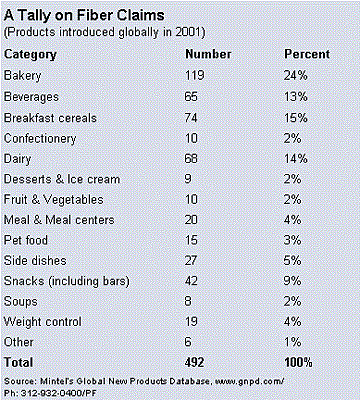
For example, a study commissioned by Kellogg's and published in the journal Appetite (2001, 37:249-250) reports that wholemeal cereals, if regularly consumed, have a positive effect on a person's mood. Professor Andrew Smith, Cardiff University, Wales, U.K., notes that a group that consumed 40g of high-fiber cereal each day showed fewer cognitive difficulties, lower depression scores, and a 10% reduction in fatigue as compared to a group that ate a “normal” breakfast.
Although several studies, (including one with ispaghula husk fiber published in the October 14, 2000 issue of The Lancet) made waves when they appeared to negate some of fibers health benefits, researchers generally agree the evidence is overwhelming that it is important to eat fiber-containing fruits, vegetables, and whole grains. All this has not been lost on marketers.
The Industry Provides
Mintel International's Global New Product Database (GNPD) identifies products by an “added fiber” designation. When searching for new products introduced in 2001 that hyped their fiber content, a list of some 492 items results. (See chart.)
Logically, bakery products, breakfast cereals and snacks (primarily in the form of energy bars) were the most popular items to tout their fiber content. Less intuitively, dairy foods also were fortified frequently with fiber, while fruit and vegetable products rarely note their fiber composition. Here is a sampling of products—from the typical to the titillating.
January 2001 started out with a bang. High-fiber cookies were introduced in India (Britannia Industries,), China (Imperial General Foods, ), Turkey (Kurtsan), Brazil (Nestle), Portugal (Triunfo) and Italy (Capezzano).
More unusual, Mead Johnson presented a reformulated Alacta-NF sweetened milk powder in Thailand that contained 5.4% added fiber in the form of inulin. The GNPD tracked the introduction of some 15 fiber-containing milks around the globe last year. A Calcium Extra Efficace Milk from Stassano (France) has added calcium and dietary fibers, said to favor the absorption of calcium.
The calcium-fiber connection also was touted by Carl Scheer, a German company that introduced a premium cheese “rich in fibre and vitamin D, which helps calcium absorption.” In all, 23 countries saw the launch of fiber-containing dairy products (other than ice cream). In the U.S., the only fiber dairy products to show up were the much bally-hooed YoSelf yogurts from Stonyfield Farms, Londonderry, N.H.
Other intriguing products include a Nestum brand “3 in 1 Cereal Drink” introduced by Nestle in Singapore. Its ingredient statement lists “sucrose, Coffee-Mate non-dairy creamer, whole wheat, rice, malt extract, degermed corn, salt, minerals, vitamins.” H.J. Heinz, under the Sonnen Bassermann brand in Germany, launched a meat-free, fiber-enriched hot pot (that's stew to those of you anchored Stateside) with potatoes and vegetables. One is tempted to assume the 25% vegetable content (carrots, leeks, onions, celery) would be the source of fiber, but the product has added inulin.
If You Got It, Flaunt It
So, from where is the fiber coming? Products may flaunt the fiber inherent in the whole foods they contain. Breakfast cereal biscuits, under the Coles Supermarkets brand in Tooronga, Australia, note they are high in fiber (from whole grain organic wheat.) In a similar vein, Narimpex in Germany points out that its Nectaflor branded apricots, prunes, figs and dates are rich in fiber, vitamins and minerals.However, more often, fiber is separately added into a food or beverage. Polydextrose appears in a low-calorie, vitamin A-, C-, E- and calcium-enriched Sunkist brand orange juice drink from Haitai Beverage in Seoul, South Korea, and in low-calorie confectionery from Senjakukan Honpo, Japan.
Bertrams Exclusive Fruit-Fibre Drink, U.K., lists gum arabic and pectin as added fiber. Corporacion Tresmontes, Chile, adds apple fiber to its Yuz brand multifruit juice, which already contains banana, apple, mango and apricot pulp.
Wheat bran also is popular. Kellogg's alone has made sure of that since May 2001, by rolling out extensions of its All-Bran breakfast cereal. The fiber from other grains and seeds (rye, oats, hemp) also shows up in products. For example, Frazer Leipomot, Helsinki, Finland, introduced its I Love crispbread as “rich in the soluble oat fiber, beta-glucan, which helps balance blood glucose and control cholesterol level.”
Such health claims, some on the package, some just hinted at in promotional literature, are not uncommon. A Tropicana Slim brand skimmed milk, by Nutrifood, Bogor, Indonesia, is fortified with dietary fiber, calcium, omega 3, vitamin A, vitamin D, vitamin E and “is said to protect the heart.” Several products make a “softer” claim in regards to how they benefit digestion. Examples include Jacob Crackers—introduced into Singapore by Danone's Britannia Brands in Johor, Malaysia—and an interesting tuna-based salad from Saupiquet in France; the fiber is derived from lentils, wheat germ, tomato, bulgar wheat and sweet corn ingredients.
It is unlikely that ispaghula fiber, that poorly-performing fiber in The Lancet study, will be used to fortify products in the near future. Both old favorites and new fiber fortifiers will be showing up in products coming to a store near you.
Sidebar: Great Expectations
Industry insiders “expect” people to consume more fiber since it's so beneficial. But people are notoroius for not doing what they “ought” to do. Developing products and the message that make fiber compelling remains an industry challenge.—Amy Stockwell, Principal, Analytech Associates, fdingred@aol.com
As the analysis and, thus, regulatory definition of dietary fiber is settled in the U.S., companies will feel more comfortable promoting dietary fiber content.
—Claudia D. O'Donnell, Chief Editor, Prepared Foods